Table of Contents
Why Dogs Fear Thunder
Thunder anxiety in dogs, also known as noise phobia, is a common behavioral condition in dogs. It’s more than just dislike—it’s a deep-rooted fear response triggered by loud noises, flashing lights, changes in barometric pressure, and even static buildup in the air. As a vet in Ottawa, I often see dogs start trembling or hiding even before a storm hits—dogs can detect shifts in air pressure or static that humans don’t notice.Thunder anxiety in dogs is the main problem which could be treated. In this content you will find many topics about it.
Thunder anxiety in dogs is a widespread issue that can disrupt both the pet’s well-being and the owner’s peace of mind. Thunder anxiety in dogs often tremble, hide, bark, or try to escape during storms. While some pups show mild unease, others experience severe distress. Recognizing the signs of thunder anxiety in dogs early is crucial for providing relief. Fortunately, there are several effective strategies to manage thunder anxiety in dogs—including calming wraps, white noise, pheromones, and behavior training. As a veterinarian, I’ve helped many pet parents create personalized plans to reduce thunder anxiety in dogs naturally and safely. With preparation and the right tools, you can help your dog feel secure even when the thunder rolls.
While some dogs only show mild signs, others enter a full-blown panic state: pacing, panting, trying to escape, or even self-injury. Genetics, early life experiences, and breed tendencies can all play a role. Herding breeds (like Border Collies) and working dogs seem particularly prone.
Signs Your Dog Is Anxious
Recognising thunder anxiety in dogs early helps you intervene before fear escalates. Common signs include:
- Trembling or shaking
- Hiding (e.g., under beds, in bathtubs, closets)
- Pacing or restlessness
- Panting heavily
- Barking, whining, or howling
- Clinginess or following you closely
- Destructive behavior (chewing, scratching doors)
- Incontinence or drooling
If your dog shows these symptoms during storms, you’re not alone—and there are safe, natural ways to help.
📝 5-Minute Home Checklist for Storm Prep
What to Gather Before Storms
When a thunderstorm is in the forecast, a few quick steps can set your dog up for comfort. Here’s a fast checklist to prepare in just five minutes:
✅ Calming gear ready (ThunderShirt, calming collar)
✅ Favorite safe space open (crate, closet, basement corner)
✅ White noise or calming playlist prepped on your phone
✅ High-value treats or stuffed toy (like a frozen Kong) on hand
✅ Pheromone diffuser plugged in or collar secured
✅ Natural calming supplement given (if already approved by your vet)
✅ Comfort items nearby (your worn shirt, blanket, brush)
✅ Essential oils diffusing (lavender, chamomile—sparingly and safely)
This simple routine can help prevent panic and show your dog they have support every time a storm rolls in.
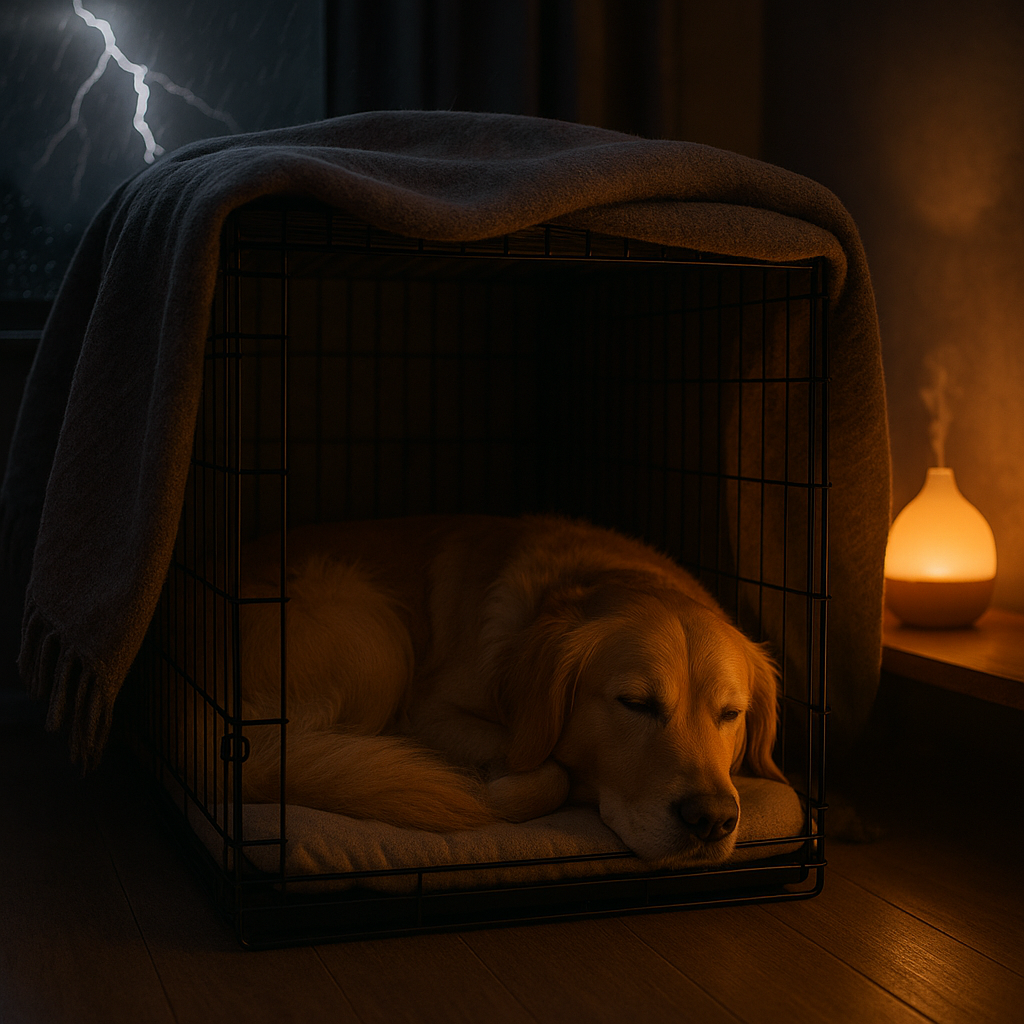
Setting Up a Safe Space
Pick a quiet, windowless room like a basement or interior closet. Add:
- Soft bedding
- A covered crate or blanket fort
- Fan, music, or white noise machine
- Familiar scents (like your shirt or used bedding)
Avoid locking them in unless they’re crate-trained and feel secure there. Some dogs feel safest when they can retreat and rejoin you freely.
Natural Calming Aids
Calming Wraps (e.g., ThunderShirt)
Pressure wraps apply gentle, consistent pressure to your dog’s torso—similar to swaddling a baby. This sensation can trigger the release of calming hormones and reduce physical signs of thunder anxiety in dogs. Products like the Thunder Shirt are popular and widely recommended by vets and trainers alike. I’ve personally seen dogs that would tremble nonstop calm down noticeably once their wrap was on.
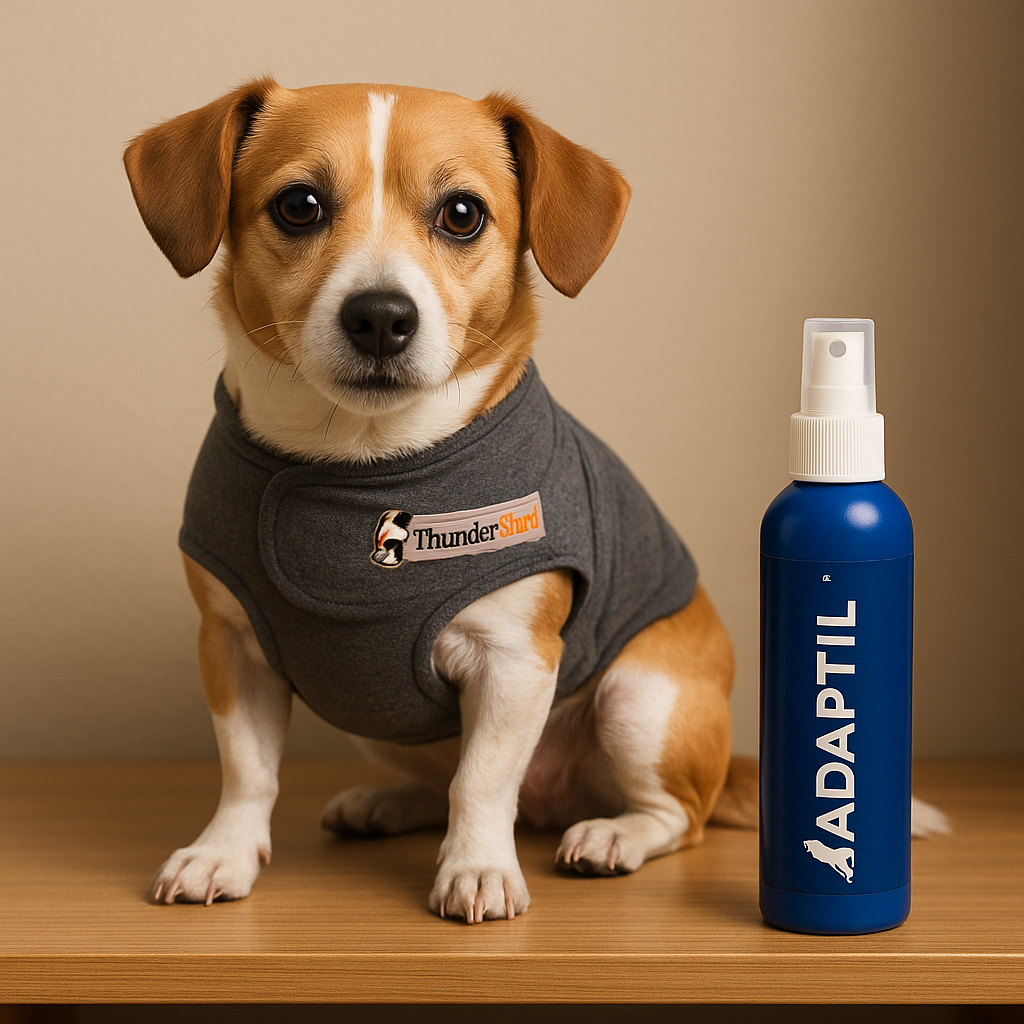
Pros:
- Drug-free and fast-acting for many dogs
- Reusable and easy to use
- Helps with multiple anxiety triggers (storms, travel, fireworks)
Cons:
- Some dogs don’t tolerate it well at first
- Needs proper fit to be effective
- May not be enough alone for severe phobia
Pheromones (Adaptil)
Adaptil mimics the comforting scent of a mother dog, helping dogs feel safe and secure. Available as a diffuser, collar, or spray, it’s clinically proven to reduce stress behaviors during storms.
Vet tip: In a 2015 study, dogs with an Adaptil collar showed ~50% fewer anxiety signs than those without.
Pros:
- Odorless to humans
- Easy to use with no training
- Works well in combination with other remedies
Cons:
- May take hours to reach full effect
- Not effective for all dogs
- Needs early setup before storms
Herbal & Nutritional Supplements

Natural calming supplements can ease storm-related thunder anxiety in dogs without sedation. Look for ingredients like:
- L-theanine (from green tea) – promotes calm without drowsiness
- Casein (alpha-casozepine) – a milk protein shown to reduce anxiety (e.g., in Zylkene)
- Valerian root, chamomile, passionflower – traditional calming herbs
- Melatonin – helps with sleep and evening relaxation
Many products (like VetriScience Composure, Solliquin, or Zylkene) combine these ingredients. I often recommend trying a vet-approved option like Zylkene for dogs who are uneasy but not in full panic.
Pros:
- Over-the-counter and generally safe
- Often tasty and treat-like
- Works well when started before storm season
Cons:
- Variable results—some dogs respond, others don’t
- Must be given before the storm
- Use caution if your dog is on other meds
Aromatherapy (Lavender, Chamomile)
A 2006 study showed that dogs exposed to lavender were less active and more restful—especially during travel or stress. Use pet-safe essential oils via diffuser (never direct on skin or fur). Good choices include:
- Lavender – well-studied calming scent
- Chamomile – mild sedative properties
- Frankincense – optional for deeper relaxation
Pros:
- Non-invasive and soothing
- Benefits both dog and human
- Works well in combination with music and massage
Cons:
- Use sparingly—dogs have strong noses
- Not all essential oils are safe for pets (avoid tea tree, peppermint, eucalyptus)
Pro tip: Lightly diffuse oils in a ventilated room—not a closed crate—and observe your dog’s comfort.
CBD: What We Know and Don’t
CBD oil and treats for dogs are growing in popularity. Some pet owners (and a few holistic vets) report success calming noise anxiety. However, a 2020 study on CBD for noise phobia showed no significant effect compared to placebo.
Use only dog-formulated, THC-free CBD from brands that offer a certificate of analysis. Dosage matters: too little = no effect; too much = sedation or side effects.
Pros:
- Natural and possibly calming
- Can be combined with other natural remedies
- May help dogs who don’t respond to supplements
Cons:
- Effectiveness not yet well-proven
- Poor quality control in the CBD market
- Should be used under veterinary guidance
Environmental Strategies
White Noise & Calming Music
Sound therapy can help mask thunderclaps and create a soothing environment. Classical music, white noise machines, or specially curated playlists like “Through a Dog’s Ear” have been shown to lower heart rates and stress indicators in dogs.
My tip as a vet: Start playing music before the storm peaks—ideally when your dog first shows subtle signs of thunder anxiety in dogs.
Ideas to try:
- Box fan or humidifier for consistent noise
- Calming playlists on Spotify or YouTube
- Pet-specific apps like Calm Pet
Pros:
- Easy and low-cost
- Non-invasive and beneficial even for the human family
- Great in combination with safe space or pheromones
Cons:
- Not powerful enough for extremely loud thunder
- Requires electricity unless you use battery-operated devices
Using Safe Spaces Effectively
Dogs naturally seek small, enclosed spaces when frightened. Build a “storm den” by setting up a crate in a quiet room (closet, basement, interior hallway). Line it with soft bedding, cover it with a blanket, and make it cozy—not confining.
Vet anecdote: I’ve had clients set up a bathroom crate with a fan, pheromone diffuser, and their own T-shirt inside. The dog began voluntarily going there when storms rolled in—and seemed far calmer.
Essentials for a calming safe zone:
- Low lighting
- White noise or soft music
- Familiar bedding and scent items
- Access to water and fresh air
Warning: Never lock a panicking dog in a space they can’t escape—this can escalate fear.
Anti-Static Tips (Storm Defender, Dryer Sheets)
Some dogs react to static electricity in the air more than thunder itself. Signs include hiding in bathtubs or rubbing against metal.
Natural static relief options:
- Lightly rub coat with unscented natural dryer sheets (e.g., Seventh Generation)
- Try a Storm Defender cape (lined with antistatic material)
- Run a humidifier to reduce static charge in the room
Pros:
- Quick fix for a commonly overlooked trigger
- May bring relief when other methods fall short
Cons:
- Not all dogs are static-sensitive
- Dryer sheets must be chemical-free and dog-safe
Behavioral Techniques & Long-Term Training
Counterconditioning (“Storm Party” Technique)
Instead of dreading storms, teach your dog that thunder = great things. Counterconditioning flips fear into anticipation by pairing thunder sounds with treats, games, or praise.
Example: Every time thunder booms, you say “Treat time!” and toss a high-value snack. Over time, your dog may actually perk up at the sound.
Tips for success:
- Use super tasty, storm-only treats (freeze-dried liver, peanut butter, cheese)
- Pair with calming tools like a ThunderShirt
- Practice during low-stress storms or with recordings
Vet advice: It’s okay to comfort your dog during storms—this doesn’t reinforce fear. You’re showing support, not rewarding bad behavior.
Desensitization with Recordings
Gradual exposure to recorded thunder sounds (at very low volume) can help your dog learn that thunder isn’t dangerous. This is best done in the off-season when storms aren’t happening daily.
How to start:
- Play thunder sounds quietly during calm moments
- Give treats, play, or engage in training
- Slowly increase volume across sessions
- Always stop before your dog gets scared
Tools:
- Thunderstorm playlists on YouTube
- Dog desensitization apps
- Bluetooth speaker to simulate ambient thunder
Pro tip: Add a flashing light (to simulate lightning) for realism as your dog progresses.
When to Consult a Trainer
If your dog’s fear is severe or worsening despite your efforts, professional help is the kindest next step. Look for:
- Certified dog trainers (CPDT-KA)
- Veterinary behaviorists (DACVB)
- Fear Free Certified professionals
They can design a custom training and desensitisation plan—often combining behavior therapy with calming aids or meds if needed.
Cost Guide: Natural vs Prescription Options in Canada
Here’s a quick look at typical Canadian pricing for various thunder anxiety aids, so you can plan what fits your budget:
| Product / Aid | Average Cost (CAD) | Notes |
|---|---|---|
| ThunderShirt | $50–65 | One-time purchase; washable; reusable |
| Adaptil Diffuser Starter Kit | $45–60 | Refill every 30 days; plug-in covers 1 room |
| Adaptil Collar (45–70 cm size) | $40–55 | Lasts about 4 weeks |
| Zylkene (225 mg for 10–30 kg dogs) | $40–50 for 30 caps | Often used daily or before storms; vet-backed supplement |
| VetriScience Composure (chews) | $35–45 for 30–60 ct | Multiple dosing options (daily or situational) |
| Storm Defender Cape | $80–100 | Static-reducing gear; not widely available in stores |
| Mutt Muffs (canine ear protection) | $60–90 | May need size adjustment; reusable |
| CBD Oil (pet-specific, 250–500 mg) | $50–100+ | Price varies widely by source; look for lab-tested pet formulas |
| Melatonin (pet-safe formulation) | $15–25 | Use only under vet guidance; no xylitol |
| Prescription Anti-Anxiety Meds | $25–60 per Rx | Trazodone, alprazolam, or Sileo; used for severe cases under vet care |
💡 Tip: Always consult your veterinarian before starting supplements, CBD, or medication—especially if your dog takes other prescriptions.
Prevention Tips & Long-Term Support
Seasonal Planning
If you live in a storm-prone area (like much of Ontario during summer), prepping ahead of time makes a big difference. Here’s how:
- Start supplements or pheromone use early, before storms hit regularly
- Condition your dog to their ThunderShirt or safe room on calm days
- Create a storm-response plan: who plays music, who gives treats, etc.
- Track storm forecasts and give calming aids at the first sign (many dogs sense storms before we do)
🐶 My clinic often advises clients to treat thunder phobia like allergies: proactive, not reactive care is key.
Lifestyle and General Anxiety Reduction
Lowering your dog’s overall stress levels helps them bounce back faster from thunder episodes.
Healthy habits include:
- Daily exercise – burns anxious energy
- Consistent routines – dogs feel safer with predictability
- Enrichment – puzzle feeders, scent games, sniff walks
- Socialization – calm dogs build more confidence over time
- Regular health checks – pain or illness can worsen anxiety
Bonus: dogs who feel physically and emotionally secure are more likely to respond to behavior training and natural calming aids.
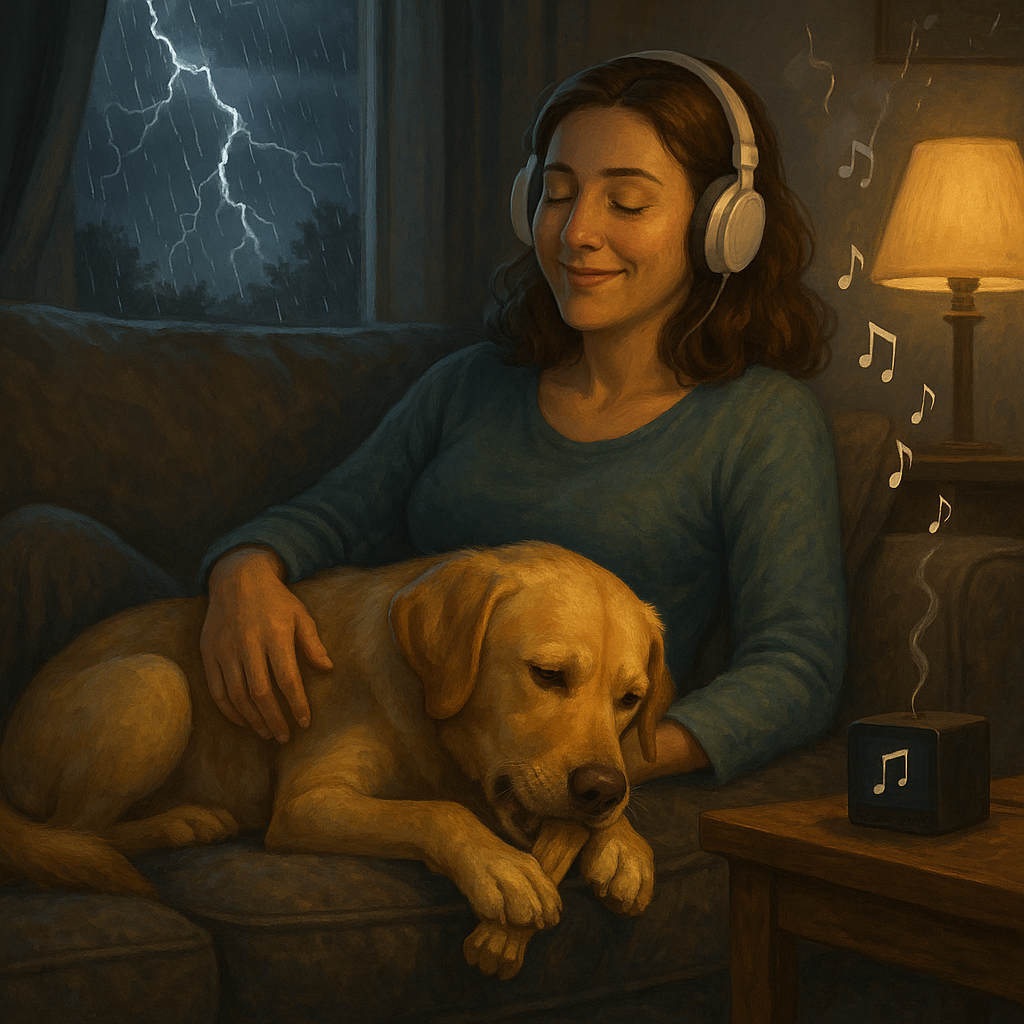
FAQs: Thunder Anxiety in Dogs
What’s the best natural remedy for thunder anxiety in dogs?
There’s no one-size-fits-all answer, but a combination often works best. Most dogs benefit from a ThunderShirt, a safe space with calming music, and either Adaptil or a vet-approved supplement like Zylkene or Composure. Severe cases may also need training or medication.
Do calming chews really work?
Yes, for many dogs—especially if used consistently and given before a storm starts. Look for products with L-theanine, casein, or valerian root, and choose reputable brands like VetriScience Composure or Zylkene.
Is CBD safe for dogs with storm phobia?
CBD may help, but results vary and quality control is an issue. Always choose pet-formulated, THC-free products and speak with your veterinarian first. Monitor for sedation or digestive upset.
Can I comfort my dog during storms or will that make it worse?
Comforting your dog does not reinforce fear. Fear isn’t a behavior—they’re not acting scared to get attention. Calm presence, gentle touch, and soothing voice help your dog feel safer.
How do I know if I need to see a vet or behaviorist?
If your dog is panicking despite all-natural methods—like destroying furniture, injuring themselves, or trembling uncontrollably—it’s time to consult a vet or certified trainer. Behavior plans or anti-anxiety meds may be needed for humane relief.

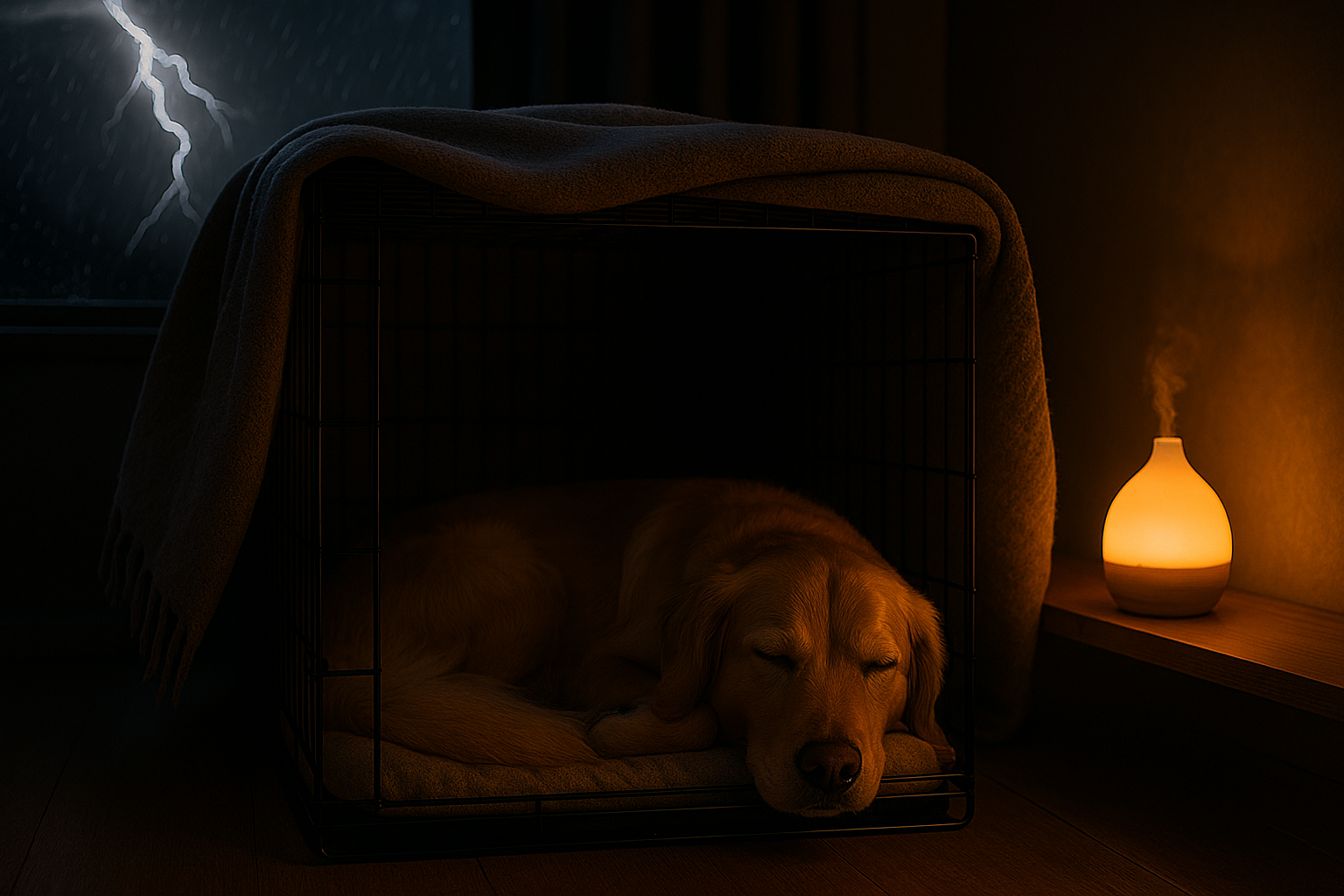
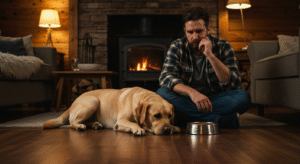
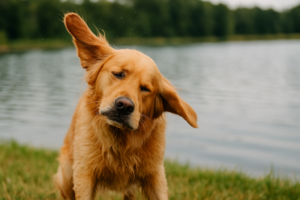
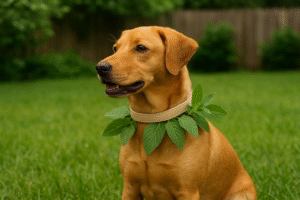
Pingback: Top 8 Proven Dog Aggression Causes: